NEPAL
Kathmandu

Kathmandu
Kathmandu
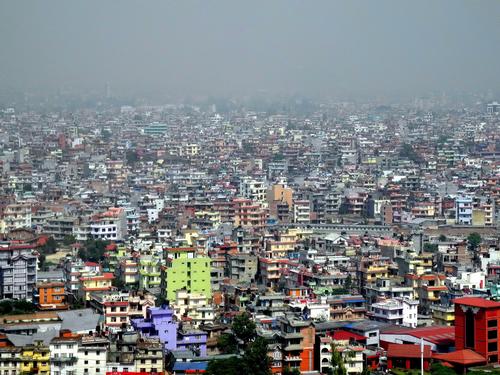 KathmanduPhoto: Royonx in the public domain
KathmanduPhoto: Royonx in the public domain
Kathmandu is the capital and largest city in Nepal. The city is the urban core of the Kathmandu Valley in the Himalayas. According to the 2010 census, Kathmandu had 989,273 inhabitants. The municipality covers 50.67 square kilometers. Kathmandu is not only the capital of the Federal Democratic Republic of Nepal, but also the capital of the central region. Tradition has it that Kathmandu was the legendary and inaccessible Shangri-La. Today it is a center for adventure travelers and a growing holiday destination. Kathmandu is considered the gateway to Nepal's tourism and is the main center of the country's economy. The city has advanced infrastructure necessary for the further development of tourism.
| advertisement |
| Hotels Kathmandu |
Location
The coordinates of Kathmandu are: 27°42 'North latitude and 85°20' East longitude. The city is located in the northwestern part of the Kathmandu Valley. It covers an area of 50.67 square kilometers. The average elevation is 1,350 meters above sea level. Eight rivers flow through the city of which Bagmati, Bishnumati, Dhobikhola, Manohara, Hanumant and Tukucha are the most important. The mountains where these rivers originate are at an altitude of 1500-3000 meters and have mountain passes that provide access to Kathmandu and the valley. Kathmandu is surrounded by four large hills: Shivapuri, Phulchowki, Nagarjun and Chandragiri. The weather conditions determine the natural vegetation in the area. In Kathmandu and the valley, the dominant tree species are oak, elm, beech and maple at the lower levels and coniferous trees at higher elevations.
Weather
The Kathmandu valley belongs to the warm temperate zone within the climate of Nepal. The country is divided into five climatic regions, depending on various geographic factors. Because the Kathmandu valley is at an altitude between 1200 and 2300 meters, the climate is quite pleasant. In the higher areas of the zone there is a colder temperate climate. Lower parts of the city have a mild form of a humid subtropical climate. In Kathmandu, the average high temperature in summer is 24.8°C, in the winter months the average low temperature is 11.7°C. In general, the city has a pleasant climate, warm days and cool mornings and evenings. Average annual rainfall is 1,425 mm, most of the rain falls during the rainy season from June to August.
History
The history of both the Kathmandu Valley and the city dates back to ancient times. The archaeological finds consist of tools from the Stone Age. An inscription from 2000 years ago has been found in the valley. Buddha was born in the southwestern part of Nepal in 563 BC.
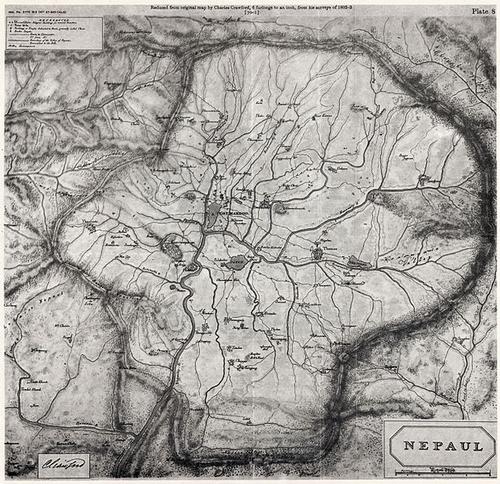 Map from Kathmandu from 1802Photo: Public domain
Map from Kathmandu from 1802Photo: Public domain
The Anglo-Nepalese War of 1814-1816 between the Kingdom of Nepal (now Federal Democratic Republic of Nepal) and the British East India Company broke out as a result of the ambitious expansionism of the British. After the decisive battle on February 28, 1816 and the fall of the Hariharpur fortress, the Ghurkhas were forced to surrender. Nepal lost Sikkim, the territory of Kumaon and Garhwal and most of the lands of the Tarai. The British East India Company had to pay 200,000 rupees annually to compensate for the loss of income from the Tarai region.
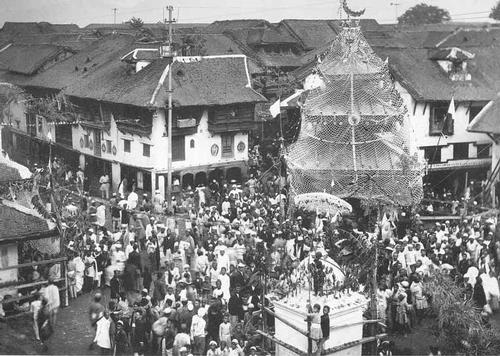 Kathmandu in 1920Photo: public domain
Kathmandu in 1920Photo: public domain
A strong earthquake hit Kathmandu in 1934 when large parts of the city were damaged. They were rebuilt to their original shape. The city has developed rapidly since the 1980s, the old core is surrounded by high-rise buildings of the various companies, new residential areas have been built and wide boulevards laid out. In 1955 King Mahendra took control of Nepal and during his reign Nepal became a member of the United Nations. The first general elections were also held in 1956 with the Congress Party winning the absolute majority.
In December 1960, King Birendra abolished multiparty democracy and Nepal was once again completely controlled by the monarchy. In 1962 a new constitution was passed legitimizing a centrally regulated system of administration Panchayat. This system formed the institutional basis of the king's rule. On April 9, 1990, the king restored multiparty democracy.
The people of Kathmandu are mainly followers of the Hindu and Buddhist religions, but there are also residents of various other religious beliefs, giving the city a cosmopolitan and tolerant feel. Nepalese is the common language of the city, English is widely understood by the educated population of the city. The literacy rate in the city is high, estimated at 98%.
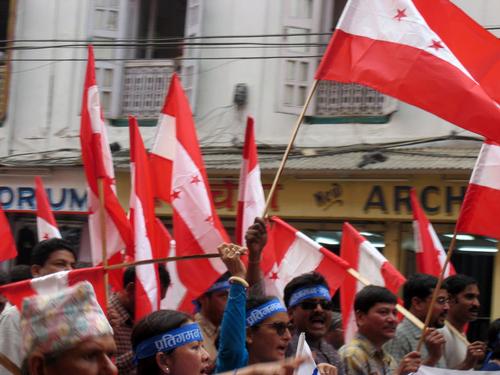 Kathmandu Protests in 2004Photo: Rich CC 3.0 Unported no changes made
Kathmandu Protests in 2004Photo: Rich CC 3.0 Unported no changes made
In recent years, Kathmandu has known a turbulent history and political instability. There were outbreaks of violence and protest, often causing significant damage to buildings or loss of life.
Sights
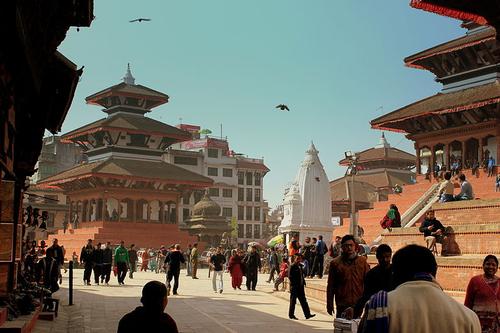 Durbar square in KathmanduPhoto: Calflier001 CC 2.0 Generic no chaanges made
Durbar square in KathmanduPhoto: Calflier001 CC 2.0 Generic no chaanges made
The Durbar square is surrounded by palaces and temples, including the Kasthamandap or "the Wooden House" from which the town's name comes. The square was built together with the palace around 1000 AD. This complex is the most popular UNESCO World Heritage Site in Nepal. It is a magical place in the early morning or in the evening. A visit to Durbar Square Museum is an absolute must. There are lots of beautiful buildings and statues in this small area. You will find: The Taleju Temple, a covered temple with a pyramid-shaped base, one of the oldest temples on the square, an example of the typical Newari architecture. On the southern side of Durbar Square you can visit Bhagwati Temple, The Saraswati temple is dedicated to the goddess of knowledge and learning. Dubar square is the center for many of Nepal's festivals.
There are other famous landmarks in Kathmandu that tourists should not miss. Some of the most important are described below.
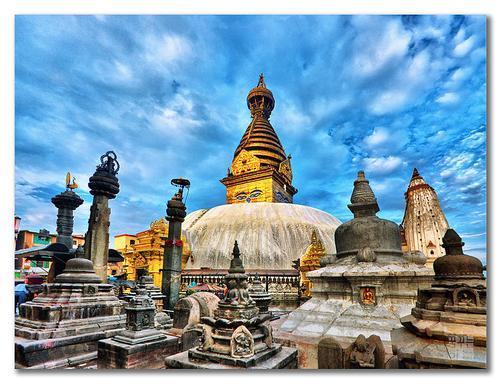 Kathmandu SwayambhunathPhoto:Dhilung Kirat CC 2.0 Generic no changes made
Kathmandu SwayambhunathPhoto:Dhilung Kirat CC 2.0 Generic no changes made
The Kathmandu Swayambhu is a large stupa (Buddhist temple) highly revered in Nepal and one of the most sacred Buddhist sites in the country. The temple is also called the monkey temple, because of the sacred monkeys that live there. The Stupa offers a great view of the city.
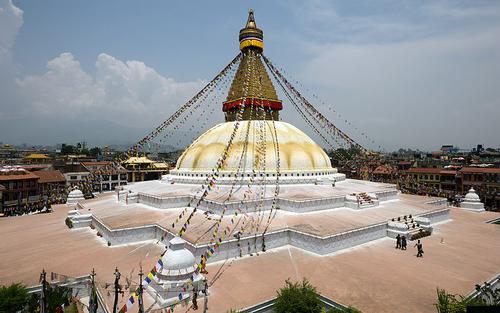 Buddha Stupa in KathmanduPhoto: Alexander Shafir CC 3.0 no changes made
Buddha Stupa in KathmanduPhoto: Alexander Shafir CC 3.0 no changes made
Buddha Stupa is also one of the most sacred places for Tibetan Buddhism. It's a must see in Kathmandu. It is a wonderfully atmospheric place to stroll, with monks in robes and numerous shrines that make visitors think they are walking through Lhasa. In the middle is the stupa. What at first glance looks like a fabulously colorful construction is actually an imitation of the Buddhist cosmos, with the elements symbolized in the design of the building.
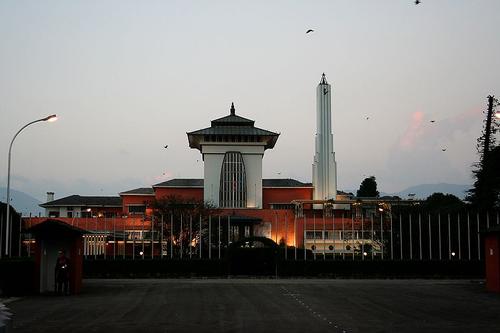 Narayanhiti Palace MuseumPhoto: Pavel Novak CC 2.5 Generic no changes made
Narayanhiti Palace MuseumPhoto: Pavel Novak CC 2.5 Generic no changes made
The Narayanhiti Palace Museum, the former Royal Palace, was transformed in 2009 partly into a museum and partly as the Ministry of Foreign Affairs. Now you can visit the beautiful halls of the main palace building. The crown jewels are counted among Nepal's most precious treasures.
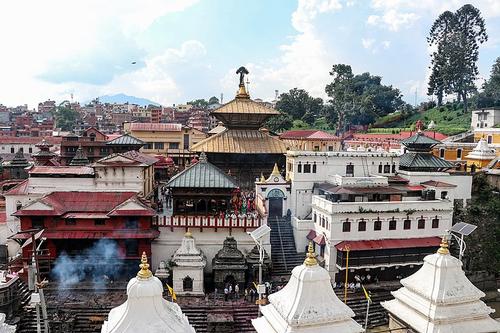 Pashupatinath temple in KathmanduPhoto: Shadow Ayush CC 4.0 International no changes made
Pashupatinath temple in KathmanduPhoto: Shadow Ayush CC 4.0 International no changes made
Pashupinathat is an important Hindu temple for Shiva in Nepal. You see monkeys and a sacred cave. Most tourists come to see the impressive cremations. The temple itself is not accessible to non-Hindus. Morning is a great time to go.
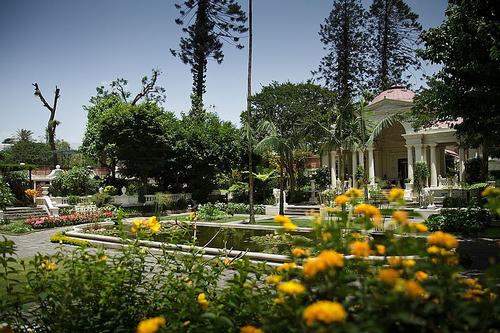 Kathmandu garden of dreamsPhoto: Thomas Fuhrmann CC 3.0 Unported no changes made
Kathmandu garden of dreamsPhoto: Thomas Fuhrmann CC 3.0 Unported no changes made
In the Garden of Dreams you can relax, it is a beautiful and quiet walled garden close to Thamal and the former Royal Palace. It is a mature garden, which was created in 1920. You see fountains and beautiful plants and the busy city is suddenly very far away.
Tips
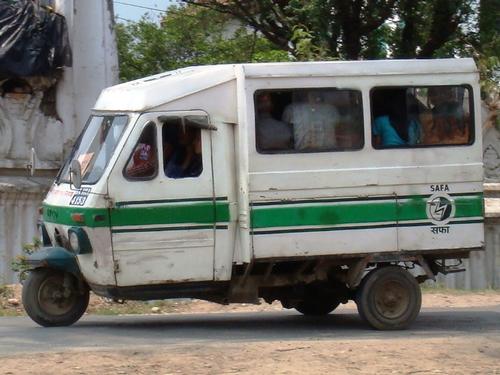 Kathmandu Shared TaxiPhoto: (WT-shared) Shoestring at wts wikivoyage CC 4.0 no changes made
Kathmandu Shared TaxiPhoto: (WT-shared) Shoestring at wts wikivoyage CC 4.0 no changes made
Kathmandu is a city that tourists who like to experience Himalayan adventures cannot ignore. As a result of the rising demand for luxury apartments, many high-rise complexes are being built. Tourists can see Kathmandu on foot, but they can also use public buses for longer trips, or rent a rickshaw in the tourist center of Thamel. They can stop with a taxi anywhere, but it is recommended to negotiate the price. Taxis are easy to find, they are close to all major streets.
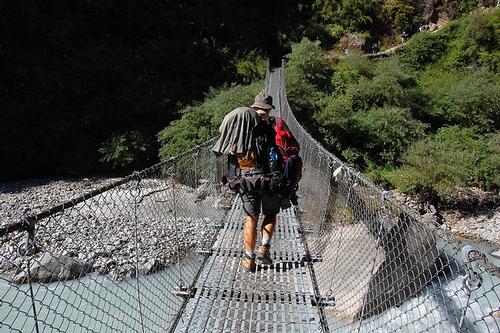 Trekking from KatmanduPhoto: Lev Yakupov CC 2.0 Generic no changes made
Trekking from KatmanduPhoto: Lev Yakupov CC 2.0 Generic no changes made
Kathmandu is a starting point for many adventures in the rest of the country, including hiking, rafting, jungle adventures, and many more extreme sports. If you would like to see some of the Himalayas, you can walk for a few days from the Kathmandu Valley. This is less intense than the trekking in the rest of the country, but can still reward you with fantastic mountain views.
Useful links Kathmandu
BBC Country ProfilesWorld Fact Book Explore all Countries
How to call
Last updated June 2025
Copyright: Team - The World of Info